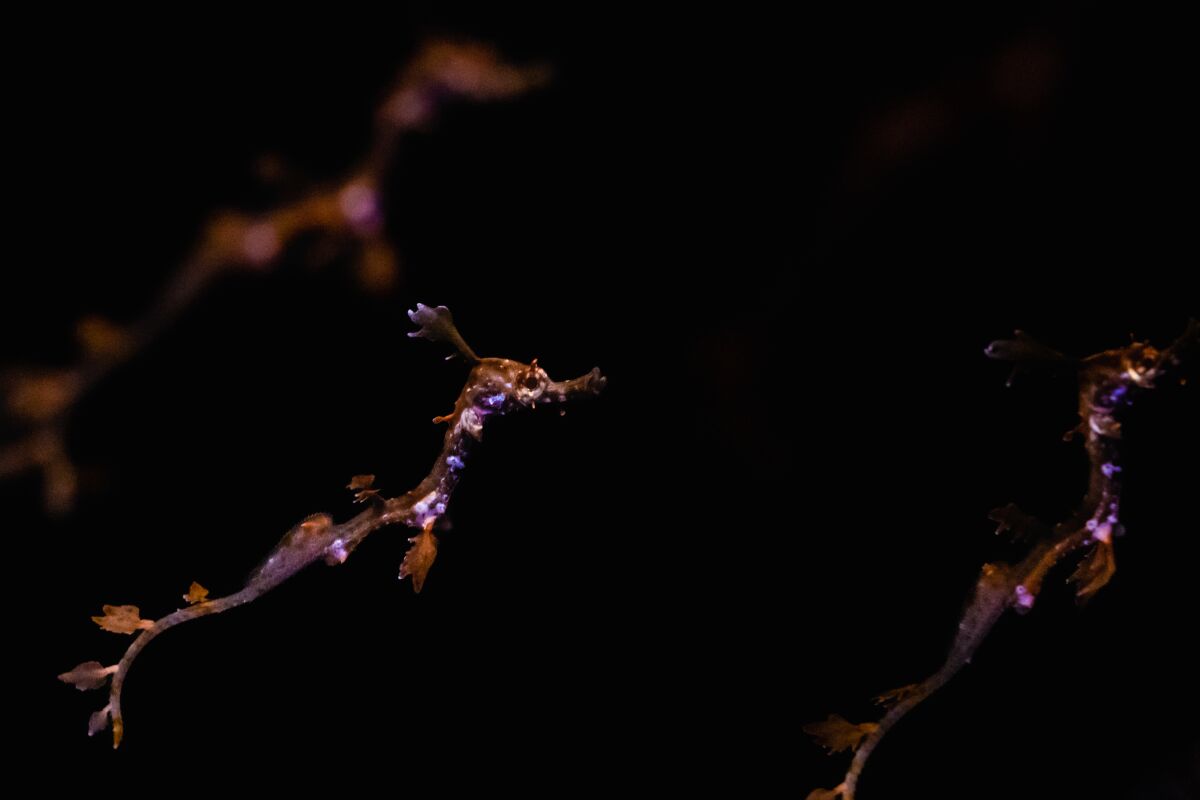More than 70 weedy seadragons have hatched at Birch Aquarium in La Jolla after a first-of-its kind egg transfer in the public eye.
The babies began hatching Feb. 26 and continued through March 2, according to the aquarium, which is at UC San Diego’s Scripps Institution of Oceanography. The “weedies” are about an inch long and weigh less than 1 gram, or 0.035 ounces.
The countdown to the births started Jan. 9 when a female weedy seadragon released nearly 100 eggs to her male partner. Seadragon males — not females — are responsible for carrying the eggs.
“It’s pretty exciting,” Birch associate curator Leslee Matsushige told the La Jolla Light on March 3. “We were hopeful all the eggs would hatch, but the fact that 70 eggs have hatched is a huge success.”
Matsushige, who leads the aquarium’s seahorse and seadragon breeding programs, previously said this is the first time Birch had seen such a large egg transfer.
“We’ve been working on this for decades,” she said this week. “This is a very challenging yet exciting process. We’ve had some previous experience raising young seadragons, so we hope to be successful raising an even greater number of babies this year.”
Once the eggs hatch, seadragon babies are fully independent, feeding on their own and fending for themselves. For now, Birch’s babies are being raised behind the scenes so aquarists can monitor and feed them a special diet, as weedy seadragons are considered notoriously picky eaters.
“They are looking good, eating like they are supposed to, so we’re excited,” Matsushige said. “It brings a lot of joy to my heart.”
Only a handful of facilities have successfully hatched and reared this unique species of fish, which is related to seahorses and pipefish. Before this, the most successful egg transfer at Birch was in 2020, when five eggs were released and two of them hatched.
But that transfer took place behind the scenes. This is the first time a seadragon has laid eggs on the public side of the aquarium.
Seadragon egg transfer has been documented only once in the wild and happens in captivity only a few times a year around the world.

Birch Aquarium’s baby “weedies” are about an inch long and weigh less than 1 gram.
(Jordann Tomasek)
“Seadragons are relatively new to human care, with their first introductions in the ‘90s,” said Jenn Nero Moffatt, senior director of animal care, science and conservation at Birch. “In that short period of time, Birch Aquarium and our colleagues have been able to learn just a bit of their amazing life history, genetics and behaviors.
“This successful breeding was the result of many years of dedication to understanding this delicate species and replicating their natural environment through changes in flow rates, water volume, lighting and water temperature, which are key to influencing their health and successful breeding. We are poised to help this species with our conservation program.”
“They are looking good, eating like they are supposed to, so we’re excited. It brings a lot of joy to my heart.”
— Leslee Matsushige, Birch Aquarium associate curator
Because the seadragons typically are found only in the grassy and kelp-filled waters of southern Australia, where it is currently summer, the water temperature in their enclosure was gradually increased in recent weeks to mimic the conditions in which the eggs would develop and hatch naturally.
The ultimate goal, Matsushige said, is to have successful egg transfers and hatching more frequently.
“If we can get better at this and this can happen again and more consistently, that would be ideal,” she said. “We want this to happen on a regular basis. We need to be able to raise them in captivity because there could be a time that the numbers would decline [and] we could raise them and release them into the wild. So we need to know how to do that before there is a problem.”
The new babies will spend up to a year behind the scenes before guests can see them. However, a monitor has been set up in the Seadragons & Seahorses exhibit with a live feed for onlookers to see the site.
Eventually, there may be an opportunity to transfer some of the seadragons to other institutions in the Association of Zoos & Aquariums as part of breeding and education programs.
With a maximum length of 18 inches, weedy and leafy seadragons tend to have a 10- to 12-year life span. Birch opened its Seadragons & Seahorses enclosure in 2019 and it features one of the world’s largest seadragon habitats.
To learn more about Birch’s seadragon breeding program and exhibitions, visit aquarium.ucsd.edu. ◆
"captivity" - Google News
March 05, 2023 at 02:43AM
https://ift.tt/lNCs21t
Birch Aquarium welcomes about 70 baby seadragons after eggs hatch in captivity - Del Mar Times
"captivity" - Google News
https://ift.tt/5RZfUJx
https://ift.tt/4Y2L5op
Bagikan Berita Ini














0 Response to "Birch Aquarium welcomes about 70 baby seadragons after eggs hatch in captivity - Del Mar Times"
Post a Comment